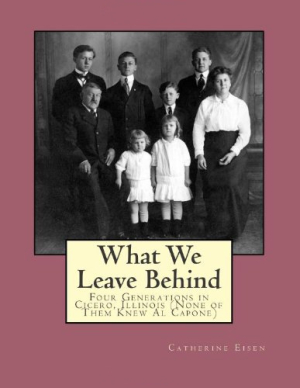
What We Leave Behind
Four Generations in Cicero, Illinois (None of Them Knew Al Capone)
This enlightening historical story, inspired by the author’s family, is a fascinating read of triumph over difficult times.
What We Leave Behind is a charming book about the author’s family, starting in the late 1800s. Partly imagined and partly backed up by documents, this book reads like a family sharing long-told tales, both joyous and devastating.
Catherine Eisen’s Great-Grandma Ellensohn (Mamie) is the backbone of this book and this family. She starts out as a young woman living with her mother (Muttie) in Iowa, where she meets and marries her husband. The couple later moves to Illinois along with Muttie, starting a family along the way. Mamie has many children, and sadly loses a few too. Her first daughter to survive, after five sons, is Madeline. Madeline’s firstborn is Dolores, followed by eight more children whom Dolores often helps take care of. Madeline’s husband becomes an alcoholic and has difficulty holding down a job. Luckily, a few of Madeline’s brothers are able to help the family financially. Dolores marries young and is soon pregnant with her firstborn daughter, the author, Catherine Eisen. The family goes through good times and bad, as is life, but they always seem to come out content.
Some sections of this book are taken directly from Mamie’s diary, a gift Catherine received as an adult. Other parts are based on census records and family documents, such as recipes from Mamie’s husband, a baker. Eisen writes in a conversational style: “That window also helps me keep an eye on the children and call them in for meals or homework or chores. Sometimes I just look out that window so I don’t have to look at all the work I need to be doing behind me in that flat.” Eisen adds in her thoughts, often with humor, in parentheses, giving her present-time view on situations or explaining something. There are sections in the book that are out of chronological order, which can be confusing, but this fits with the tone, like a family sitting around telling different memories.
There are quite a few typos and spelling errors, but it isn’t terribly distracting as large portions are portrayed in first person, diary style, as imagined by Eisen.
The author includes many family photos, so the reader is able to put a face with a name, from the earliest of Eisen’s relatives portrayed. Also included are postcards and “close-to” photos: an image that is similar to what an object was like. While this book is based on just this family, many aspects are relatable to general family life and the history of the time, as Eisen describes clothes and daily life over a one-hundred-year period, which is interesting.
This enlightening historical story, inspired by the author’s family, is a fascinating read of triumph over difficult times.
Reviewed by
Beth VanHouten
Disclosure: This article is not an endorsement, but a review. The publisher of this book provided free copies of the book and paid a small fee to have their book reviewed by a professional reviewer. Foreword Reviews and Clarion Reviews make no guarantee that the publisher will receive a positive review. Foreword Magazine, Inc. is disclosing this in accordance with the Federal Trade Commission’s 16 CFR, Part 255.
